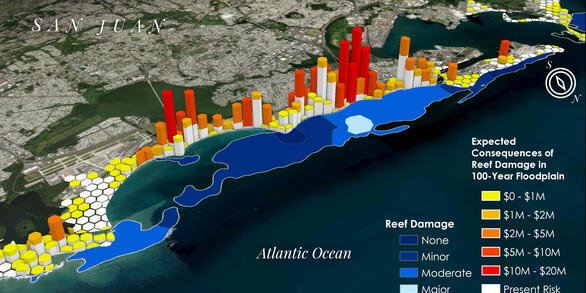Publications
Scientific reports, journal articles, and information products produced by USGS Pacific Coastal and Marine Science Center scientists.
Filter Total Items: 1369
U.S. Geological Survey global seabed mineral resources
The U.S. Geological Survey (USGS) provides science and data on seabed mineral resources and ecosystems, as well as on the potential hazards associated with extraction. The Nation relies on minerals for infrastructure, technology, manufacturing, and energy production. Critical minerals are essential to the economic and national security of the United States and have a supply chain...
Decadal-scale effects of a dam removal on channel geomorphology, sediment and large wood on the Elwha River, Washington, USA
The removal of Glines Canyon Dam on the Elwha River in western Washington, USA, from 2011 to 2014 introduced a 20-Mt pulse of stored sediment and logs into the downstream channel. We used terrestrial laser scanning, high-resolution orthoimages, and surveys of large wood (LW) and sediment grain-size distribution to quantify changes to the channel and LW in four different geomorphic...
Authors
Lisa Ely, Alyssa DeMott, Bryon J. Free, Andrew C. Ritchie
Letter to Editor regarding “Potential impact of the 2023 Lahaina wildfire on the marine environment: Modeling the transport of ash-laden benzo[a]pyrene and pentachlorophenol” by Downs et al. (2024) https://doi.org/10.1016/j.scitotenv.2024.176346
No abstract available.
Authors
Curt Storlazzi, Renee K. Takesue, Alicia Hendrix
Did the Aleutian Basin form by plate capture or backarc basin opening?
The origin of the Aleutian Basin is unresolved because its crust is deeply buried beneath sediments. It has been interpreted as forming in the Eocene when the Beringian convergent margin jumped seaward to south of the Aleutian arc, thereby capturing a large sector of Cretaceous Pacific crust. Alternatively, it may have formed by backarc spreading. We present new magnetic and seismic...
Authors
Robert J. Stern, David W. Scholl, Matthew A. Malkowski, Kylara M. Martin, Ginger Barth, Daniel Scheirer
Developing a probabilistic tsunami hazard assessment framework for Pacific sources: USGS Powell Center meeting summary
Multi-organizational principal investigators formed a U.S. Geological Survey (USGS) Powell Center Working Group (WG), Tsunami Source Standardization for Hazards Mitigation in the United States, to develop a comprehensive series of sources capable of generating tsunamis that could impact U.S. state and territory coastal areas using probabilistic tsunami hazard analysis (PTHA). PTHA...
Authors
Jason R. Patton, Stephanie L Ross, Marie C. Eble, Christodoulos Kyriakopoulos, Patrick J. Lynett, DmitriyJ. Nicolsky, Kenneth Ryan, Hong Kie Thio, Rick I. Wilson, Baoning Wu
Characterizing sedimentary organic carbon in a hydrothermal spreading center, the Escanaba Trough
Sediments in critical marine mineral environments are of wide importance due to their preservation of both marine minerals and organic carbon (OC) stocks. However, OC storage and cycling is often overlooked in mineral system studies. This work characterizes sedimentary OC within the Escanaba Trough, a hydrothermal sulfide system off the coast of northern California. By utilizing ROV...
Authors
Hope Lee Ianiri, Pamela L. Campbell‐Swarzenski, Amy Gartman, Nancy G. Prouty
Shoreline seasonality of California’s beaches
We report on remote sensing techniques developed to characterize seasonal shoreline cycles from satellite-derived shoreline measurements. These techniques are applied to 22-yr of shoreline measurements for over 777 km of beach along California's 1,700-km coast, for which the general understanding is that shorelines exhibit winter-narrow and summer-recovery seasonality. We find that...
Authors
Jonathan Warrick, Daniel D. Buscombe, Kilian Vos, Hannah Kenyon, Andrew C. Ritchie, Mitchell D. Harley, Catherine Nicole Janda, Jess L'Heureux, Sean Vitousek
Coral reef restoration can reduce coastal contamination and pollution hazards
Coral reef restoration can reduce the wave-driven flooding for coastal communities. However, this protection has yet to be assessed in terms of the reduced risk of flood-driven environmental contamination. Here we provide the first high-resolution valuation of the reduction of flood-related land-based environmental pollution provided by potential coral reef restoration. Along Florida’s...
Authors
Marina Rottmueller, Curt Storlazzi, Fabian Frick
Hybrid coral reef restoration can be a cost-effective nature-based solution to provide protection to vulnerable coastal populations
Coral reefs can mitigate flood damages by providing protection to tropical coastal communities whose populations are dense, growing fast, and have predominantly lower-middle income. This study provides the first fine-scale, regionally modeled valuations of how flood risk reductions associated with hybrid coral reef restoration could benefit people, property, and economic activity along...
Authors
Curt Storlazzi, Borja Reguero, Kristen C. Alkins, James B. Shope, Aaron Cole, Camila Gaido-Lassarre, T. Shay Viehman, Michael W. Beck
Post-fire sediment yield from a western Sierra Nevada watershed burned by the 2021 Caldor Fire
Watershed sediment yield commonly increases after wildfire, often causing negative impacts to downstream infrastructure and water resources. Post-fire erosion is important to understand and quantify because it is increasingly placing water supplies, habitat, communities, and infrastructure at risk as fire regimes intensify in a warming climate. However, measurements of post-fire sediment...
Authors
Amy E. East, Joshua B. Logan, Peter Dartnell, Helen Willemien Dow, Donald N. Lindsay, David B. Cavagnaro
Shoreline change of western Long Island, New York, from satellite-derived shorelines
Shoreline measurement techniques using satellite-derived imagery can provide decades of observations of shoreline change. Here we apply these techniques to the western south shore of Long Island, New York, which has three distinct beaches, Rockaway Peninsula, Long Beach, and Jones Beach Island, which are 18, 15, and 24 km in length, respectively. These beaches are recreation areas for...
Authors
Catherine Nicole Janda, Jonathan Warrick, Daniel Buscombe, Sharon Batiste
Tsunami and seiche hazards in site evaluation for nuclear installations
No abstract available.
Authors
Intenational Atomic Energy Agency, Eric L. Geist



